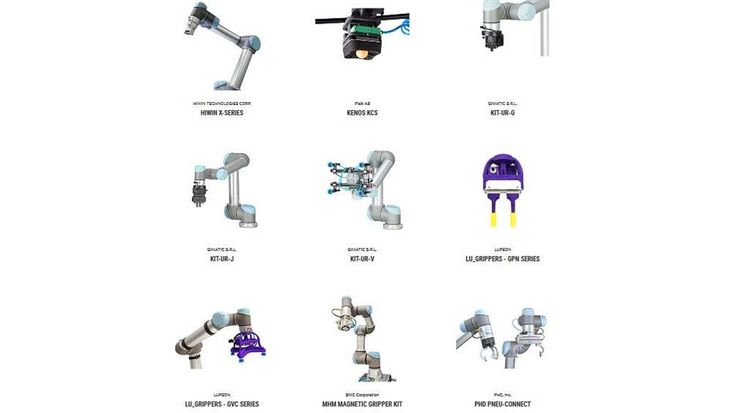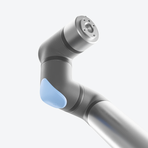Robotic gripper technology empowers robot arms to interact with objects, as well as the environment around them. Depending on the type of gripper you choose to deploy, you’ll enjoy the benefits of extreme precision and delicate handling of complex and/or fragile objects.
How to Choose the Best Robotic Gripper for your work?

Robotic gripper technology empowers robot arms to interact with objects, as well as the environment around them. Depending on the type of gripper you choose to deploy, you’ll enjoy the benefits of extreme precision and delicate handling of complex and/or fragile objects.
Robot arms are part of the Universal Robots ecosystem, along with an infinite number of purpose-built grippers that leverage the dexterity of our collaborative robot arms. There are many different types of grippers on the market with a huge variety of capabilities. We hope our small guide will help you pick the best robotic gripper for your work.

Questions to answer when selecting a gripper:
There are many different types of grippers in robotics –from mechanical gripper types to soft grippers and more-- and multiple variables that can impact your decision. Your Universal Robots account executive can help you create an end-to-end solution to meet your needs. We’ll work together to consider the following factors:
What tasks will be performed?
It’s important to visualize, in detail, what tasks the robot will be performing for your company. What materials will the gripper come into contact with? How quickly do you need to complete the task? How precise do you need to be? How often will the task change? What will the operating environment be like?
How heavy are the objects that need to be manipulated?
Both the robot arm and the gripper will need to be able to accommodate the weight and size of the object you plan to move. This is one reason it’s important to have an expert help you craft your solution. Universal Robots has robot arms designed for different weight classes. Each one is fully compatible with the robot grippers required to complete your tasks.

Will you be working with food or pharmaceutical items?
There are stricter government regulations when working with items designed to be consumed by humans. Hydraulic grippers are often forbidden in such applications because of the potential for a fluid leak in a line contaminating the product. If you are operating in a clean room, vacuum grippers may not be allowed because of the potential for additional airflow to bring contaminants into the air.
These may seem like extreme examples, but it’s important to understand these limitations before investing in collaborative robot solutions.
How fast do you need the gripper to secure and release?
Robot arms and grippers wear down over time and require maintenance. Our team can help you understand these costs ahead of time, based on the plan we put together. One factor that impacts wear and tear is cycle time, as well as the force of the grip required.
The cycle time is determined by how quickly a gripper fully opens (releases) and closes (securing) the item. Again, it’s best to consult one of our professionals that can help you create an end-to-end solution to achieve your goals with predictable operating costs.
Once the above questions are answered, you can start selecting the gripper type for your job.
What do you want to grip?
Depending on the mission, grippers can leverage a variety of materials and forces to manipulate objects. Universal Robots produces arms that are compatible with a variety of end-of-arm tooling (EOAT) solutions. These grippers rely on 5 different types of power.
Servo-Electric Grippers
Servo-electric grippers rely on electric motors that respond to precise input from a computer. The robot control unit provides the gripper with instructions based on the task to be completed, as well as the object’s specifications. Servo-electric motors engage the control surfaces to accomplish the assignment.
One key advantage is the clean, streamlined design. No additional lines are required for hydraulic or pneumatic pressure. All of the components are contained within the gripper assembly.
Pneumatic Grippers
Pneumatic grippers rely on precise pressure from a compressed air supply network for the power to open and close their gripper. Too much pressure could result in damage, but without enough pressure the object falls away.
Parallel grippers often use this technology. They get their name from the fact that the gripping surfaces remain perfectly parallel at all times, regardless of position or pressure exerted. A precise amount of pneumatic pressure is applied to pistons that manipulate the gripper, forcing it to open or close around an object.
Hydraulic Grippers
Hydraulic grippers use a similar principle to pneumatic grippers. Fluid is pressurized, instead of air. The pistons transfer the force to the claw, opening and closing it around the object.
Both hydraulic and pneumatic grippers require pressurized lines to be run to the units. Unlike servo-electric grippers, the motor applying the pressure is located remotely. This means that a single pressurization system can supply pressure for multiple collaborative robots.
Vacuum Grippers
Vacuum grippers rely on suction to grab objects. It may be helpful to envision the hose attachment on your vacuum cleaner. With enough suction and structural reinforcement, you could lock onto and manipulate objects throughout your home.
Industrial vacuum grippers can be designed to manipulate a variety of objects - from something as small and delicate as a tiny piece of chocolate, to as large and rigid as a pallet of construction materials.
Magnetic Grippers
Magnets can be used to secure any type of gripper to a robot arm. Electromagnets or pneumatically actuated magnets can be used by a gripper to temporarily secure and manipulate objects.
These are often used when manipulating thin metal objects, especially if the metal has holes in it - preventing a vacuum gripper from creating a secure seal.
What task do you have?
Advances in technology continue to shrink the gap between human workers and robots. Universal Robots’ collaborative robots allow companies to blend the strengths of both, greatly improving productivity and enhancing worker safety.
These capabilities are further expanded by selecting one of the robot hand grippers available on the market. These include various types of mechanical grippers, soft grippers, parallel grippers and even robot end-effectors that can mimic human hands.

There are a variety of end of arm tooling configurations that are fully compatible with UR’s systems:
Bellows Gripper
This pneumatic gripper has a circular rubber bladder that is positioned around the object. The bladder is inflated to secure the object, and then deflated to release it. The relatively large area of surface contact allows for the secure manipulation of objects that might otherwise be marred by metal jaws.
Grippers with 2 Fingers
This broad category of grippers has two jaws that close to secure an object. The jaws may close to clamp onto, around or through the object (imagine picking up a key chain by placing your fingers together through the loop).
Grippers with 3 Fingers
This is also a broad category of grippers. Instead of 2, there are 3 individual jaws present. The third jaw can provide additional support and allow it to grip more complex objects, although this functionality comes at a more expensive price tag than grippers with 2 fingers.
Jamming Gripper
A flexible gripper shares some capabilities with a soft gripper. It is pneumatically controlled and involves a bag filled with small grains of sand-like material. The bag is lowered onto and/or pressed against the object.
The loosely-packed bag conforms to the shape of the object to be moved. Once the air is removed from the bag, the grains are compressed into a solid grip around the object. It can then securely move the object until air is let back in, releasing the grip.
Needle Gripper
These grippers have a number of needles that puncture into the object to secure it. These are most commonly used by textile manufacturers, or other applications where a porous object needs to be precisely moved. Once the robot arms moves it into position, pneumatic pressure or electric motors can be used to deploy and retract the needles.
Soft Gripper
Soft grippers can involve complex designs that use multiple types of material and force to secure oddly shaped and/or fragile objects. They require pneumatic or hydraulic force to change shape and gently conform around an object. The sensors in some soft grippers allow for real-time adaptation to gently secure the object.
These are just some examples. If you have additional questions, our team is standing by to help you. The quickest way to reach us is by clicking here. You can also find a local Universal Robots distributor or book a robot demo.

- Universal Robots USA, Inc
- 27175 Haggerty Road, Suite 160
- 48377 Novi, MI